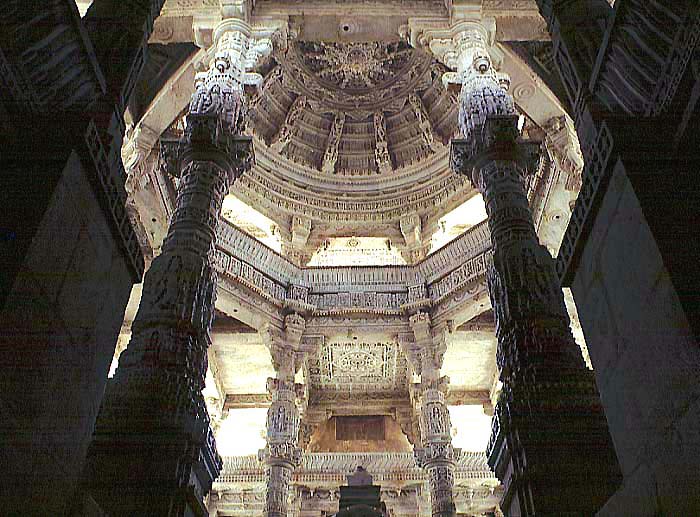
ADINATHA TEMPLE, RANAKPUR,
15th century. from
"The Penguin Guide to the Monuments of India" vol. 1, Buddhist, Jain, Hindu, by
George Michell, 1989.
Central Main Shrine is called "Mula-prasada," its interior is "Garbagriha"
(sanctum), its main statue is "Mulanayaka." In the type of Chaturumukha (four
faced) shrine unlike the case of Mt. Abu, there are not "Gudha-mandapa" (closed
hall) and "Trika-mandapa" (vestibule), but four "Ranga-mandapas" (
A, assembly hall) in
front of four portals of the main shrine. Each Ranga-mandapa connects with three
storyed "Meghanada-mandapa" ( B, high hall) in front.
Having four "Mahadara-prasada" (two faced shrine) diagonally in four directions
of the main shrine, the temple type is "Panchayatana" (five shrined type). In
addition to this, there are two "Bhadra-prasada" east and west sides, making the
total composition much more intricate. A line of "Deva-kulika" (small shrine)
along "Bhamati" (cloister) surround the whole complex. All these shrines hold a
statue of Tirthankara or Jina (four in Chaturmukha, two in Mahadara-prasada),
there are more than 100 statues in total.
¡@

http://www.ne.jp/asahi/arc/ind/jaina/6_ranakpur/ran_eng.htm

Adinatha Temple deep in the mountains, Ranakpur, 1439

http://www.ne.jp/asahi/arc/ind/jaina/7_pilgrim/xranakpur.htm
¡@
¡@
¡@
¡@